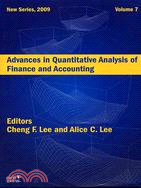Advances in Quantitative Analysis of Finance and Accounting (New Series)
is an annual publication designed to disseminate developments in the quantitative
analysis of finance and accounting. The publication is a forum for statistical and
quantitative analyses of issues in finance and accounting as well as applications of
quantitative methods to problems in financial management, financial accounting,
and business management. The objective is to promote interaction between
academic research in finance and accounting and applied research in the financial
community and the accounting profession.
The papers in this volume cover a wide range of topics including corporate
finance and debt management, earnings management, equity market, auditing,
option pricing theory, and interest rate theory.
In this volume there are eleven chapters, five of them are corporate finance
and debt management: 1. Liquidity and Adverse Selection: Evidence from the
Five-or-Fewer Rule Change; 2. Changing Business Environment and the Value
of Relevance of Accounting Information; 3. Pricing Risky Securities in Hidden
Markov-Modulated Poisson Processes; 4. An Empirical Assessment of Alternative
Dividend Expectation Models; 5. Quantitative Market Risk Disclosure, Bond
Default Risk and The Cost of Debt: Why Value At Risk? There are two of the other
six chapters which cover interest rate theory: 1. Positive Interest Rates and Yields:
Additional Serious Considerations; 2. Collapse of Dimensionality in the Interest
Rate Term Structure.
The remaining four chapters cover financial analysts earnings forecasts, equity
market, auditing, and option pricing theory. These four papers are: 1. Investors’
Apparent Under-weighting of Financial Analysts’ Earnings Forecasts: The Role
of Share Price Scaling and Omitted Risk Factors; 2. Predicting Stock Price by
Applying the Residual Income Model and Bayesian Statistics; 3. Intertemporal
Associations Between Non-Audit Services and Auditors’ Tendency to Allow
Discretionary Accruals; 4. Put Option Portfolio Insurance vs. Asset Allocation.
【作者簡介】
Center for Pacific Basin, Business, Economics, and Finance Research
James S. Ang The Florida State University, U.S.A.
Christopher B. Barry Texas Christian University, U.S.A.
Stephen J. Brown New York University, U.S.A.
Edwin Burmeister Duke University, U.S.A.
Carl R. Chen The University of Dayton, U.S.A.
Ren-Raw Chen Rutgers University, U.S.A.
Son N. Chen National Chengchi University, Taiwan
Cheol S. Eun Georgia Institute of Technology, U.S.A.
Jack C. Francis Baruch College, U.S.A.
Chin-Wen Hsin Yuan-Ze University, Taiwan
Ping Hsiao San Francisco State University, U.S.A.
Dong Cheol Kim Rutgers University, U.S.A.
Stanley J. Kon Smith-Breedan Associate, Inc., U.S.A.
Yun Lin National Taiwan University, Taiwan
Scott C. Linn University of Oklahoma, U.S.A.
William T. Moore University of South Carolina, U.S.A.
R. Richardson Petti University of Houston, U.S.A.
C. W. Sealy University of North Carolina –Charlotte, U.S.A.










